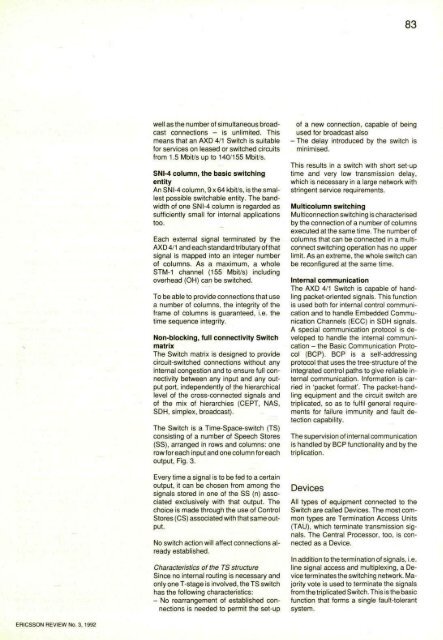An Introduction to the Ericsson Transport Network Architecture ...
An Introduction to the Ericsson Transport Network Architecture ...
An Introduction to the Ericsson Transport Network Architecture ...
You also want an ePaper? Increase the reach of your titles
YUMPU automatically turns print PDFs into web optimized ePapers that Google loves.
83<br />
well as <strong>the</strong> number of simultaneous broadcast<br />
connections - is unlimited. This<br />
means that an AXD 4/1 Switch is suitable<br />
for services on leased or switched circuits<br />
from 1.5 Mbit/s up <strong>to</strong> 140/155 Mbit/s.<br />
SNI-4 column, <strong>the</strong> basic switching<br />
entity<br />
<strong>An</strong> SNI-4 column, 9 x 64 kbit/s, is <strong>the</strong> smallest<br />
possible switchable entity. The bandwidth<br />
of one SNI-4 column is regarded as<br />
sufficiently small for internal applications<br />
<strong>to</strong>o.<br />
Each external signal terminated by <strong>the</strong><br />
AXD 4/1 and each standard tributary of that<br />
signal is mapped in<strong>to</strong> an integer number<br />
of columns. As a maximum, a whole<br />
STM-1 channel (155 Mbit/s) including<br />
overhead (OH) can be switched.<br />
To be able <strong>to</strong> provide connections that use<br />
a number of columns, <strong>the</strong> integrity of <strong>the</strong><br />
frame of columns is guaranteed, i.e. <strong>the</strong><br />
time sequence integrity.<br />
Non-blocking, full connectivity Switch<br />
matrix<br />
The Switch matrix is designed <strong>to</strong> provide<br />
circuit-switched connections without any<br />
internal congestion and <strong>to</strong> ensure full connectivity<br />
between any input and any output<br />
port, independently of <strong>the</strong> hierarchical<br />
level of <strong>the</strong> cross-connected signals and<br />
of <strong>the</strong> mix of hierarchies (CEPT, NAS,<br />
SDH, simplex, broadcast).<br />
The Switch is a Time-Space-switch (TS)<br />
consisting of a number of Speech S<strong>to</strong>res<br />
(SS), arranged in rows and columns: one<br />
row for each input and one column for each<br />
output, Fig. 3.<br />
Every time a signal is <strong>to</strong> be fed <strong>to</strong> a certain<br />
output, it can be chosen from among <strong>the</strong><br />
signals s<strong>to</strong>red in one of <strong>the</strong> SS (n) associated<br />
exclusively with that output. The<br />
choice is made through <strong>the</strong> use of Control<br />
S<strong>to</strong>res (CS) associated with that same output.<br />
No switch action will affect connections already<br />
established.<br />
Characteristics of <strong>the</strong> TS structure<br />
Since no internal routing is necessary and<br />
only one T-stage is involved, <strong>the</strong> TS switch<br />
has <strong>the</strong> following characteristics:<br />
- No rearrangement of established connections<br />
is needed <strong>to</strong> permit <strong>the</strong> set-up<br />
of a new connection, capable of being<br />
used for broadcast also<br />
- The delay introduced by <strong>the</strong> switch is<br />
minimised.<br />
This results in a switch with short set-up<br />
time and very low transmission delay,<br />
which is necessary in a large network with<br />
stringent service requirements.<br />
Multicolumn switching<br />
Multiconnection switching is characterised<br />
by <strong>the</strong> connection of a number of columns<br />
executed at <strong>the</strong> same time. The number of<br />
columns that can be connected in a multiconnect<br />
switching operation has no upper<br />
limit. As an extreme, <strong>the</strong> whole switch can<br />
be reconfigured at <strong>the</strong> same time.<br />
Internal communication<br />
The AXD 4/1 Switch is capable of handling<br />
packet-oriented signals. This function<br />
is used both for internal control communication<br />
and <strong>to</strong> handle Embedded Communication<br />
Channels (ECC) in SDH signals.<br />
A special communication pro<strong>to</strong>col is developed<br />
<strong>to</strong> handle <strong>the</strong> internal communication<br />
- <strong>the</strong> Basic Communication Pro<strong>to</strong>col<br />
(BCP). BCP is a self-addressing<br />
pro<strong>to</strong>col that uses <strong>the</strong> tree-structure of <strong>the</strong><br />
integrated control paths <strong>to</strong> give reliable internal<br />
communication. Information is carried<br />
in 'packet format'. The packet-handling<br />
equipment and <strong>the</strong> circuit switch are<br />
triplicated, so as <strong>to</strong> fulfil general requirements<br />
for failure immunity and fault detection<br />
capability.<br />
The supervision of internal communication<br />
is handled by BCP functionality and by <strong>the</strong><br />
triplication.<br />
Devices<br />
All types of equipment connected <strong>to</strong> <strong>the</strong><br />
Switch are called Devices. The most common<br />
types are Termination Access Units<br />
(TAU), which terminate transmission signals.<br />
The Central Processor, <strong>to</strong>o, is connected<br />
as a Device.<br />
In addition <strong>to</strong> <strong>the</strong> termination of signals, i.e.<br />
line signal access and multiplexing, a Device<br />
terminates <strong>the</strong> switching network. Majority<br />
vote is used <strong>to</strong> terminate <strong>the</strong> signals<br />
from <strong>the</strong> triplicated Switch. This is <strong>the</strong> basic<br />
function that forms a single fault-<strong>to</strong>lerant<br />
system.
















